1/9/04 Now I'm getting clicks from digital photographers looking for infromation the 1.5 X factor between 35mm cameras and digital cameras and for lens focal lengths relative to the angel of the field-of-view. Other web pages seem to cover this area very well, but I'll add my 2 cents worth.
 The 1.5 factor results from the difference in width of the imaging area between the CCD sensor and the 35mm full-film frame width. The width of the image on standard full-frame 35mm film is 36 mm and a typical CCD sensor is about 24 mm. The ratio of the two is 1.5.
The 1.5 factor results from the difference in width of the imaging area between the CCD sensor and the 35mm full-film frame width. The width of the image on standard full-frame 35mm film is 36 mm and a typical CCD sensor is about 24 mm. The ratio of the two is 1.5.
To get the same angle of view on a 35mm camera as on a digital camera with a 24mm wide CCD would requires a lens with a focal length of 1.5 x the focal length used on the digital camera. So a 75mm lens on a 35mm camera would equal a 50mm lens on a digital. Or conversely, to get the same angle of view with a digital that a standard 50mm lens provides on a 35mm, a 33mm focal length lens would be required. That‘s 50 divided by 1.5. This can easily be shown using geometry and the rules for right triangles.
Now consider this thought experiment. You have a 35mm camera with 75mm lens mounted on a tripod. Over this camera you hold (or mount) a digital camera (24mm wide CCD sensor) with a 50mm lens. Will the two cameras cover a different area of the view? Will there be a difference in perspective? The answer to both questions is “No.” Based on the 1.5 x factor, the same angle of view is obtained with each lens/image frame size combination. Thus the same area of the scene is covered. Since the two cameras are at the same location, the perspective is the same for both.
This drawing illustrates the method of determining the angles and rations. If someone will express interest in this subject by leaving a note in my guest book or by e-mail (jamesmskipper@netzero.com), I’ll upload a table with 35mm and CCD sensor angles-of-view for various lens focal lengths.
I get so many 'clicks' on this page from people searching for photographic perspective techniques that I decided to add to it. Click the button to see a page illustrating subject-to-camera distance as it relates to photographic (and visual) perspective. I have two examples. The first set is head-and-shoulders protraits at three distances using various lens focal lengths. The second set is architectual or geometrical perspective again at three distances with different focal length lenses.
| Newer Photographic Perspective Photo Examples |
|---|
| Original Perspective Photo Examples Are Lower On Page |
|---|
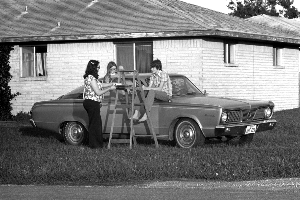
To illustrate the effect of camera-to-subject distance on perspective, photos using lenses of various focal lengths should be made from the same location. I made one photo using a 135mm telephoto and then one using a 50mm or 35mm.
I then enlarged the central area of the photo made with the wider angle lens by using photo software to crop the area I wanted and to resize it to match the telephoto image size. It is evident that the cropped wide-angle image at the lower right and the telephoto image above it are practically identical; only the subjects have moved. The full frame of the wide-angle photo is included below for comparison.
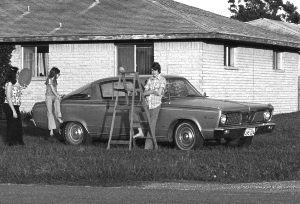
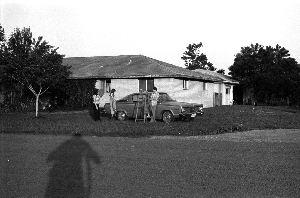
Again, the two images at the bottom were both made from the same negative. The cropped and enlarged image on the right exhibits the same perspective as the image above it that was made with the telephoto lens. If you look closely at the positions of my wife, son, and daughter in the two lower images, you will see that those images are from the same negative while the one above is from a different. The point is that perspective depends upon subject to camera distance and not lens focal length.

The automobile is a 1966 Barracuda that I bought new. It ran for 160,000 miles and then a couple of exhaust valves burned. (It had 'solid' lifters and apparently I was not deligent in keeping them adjusted.) It's sitting in the garage now. The re-worked heads have not been put back on. I guess I'll pull the engine one day (my sons will help) and get it overhauled and running again.
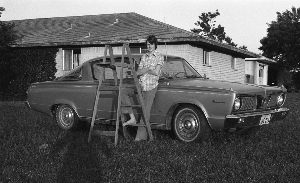
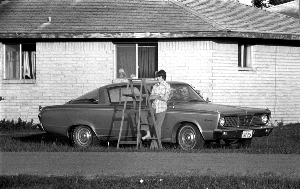 The center photo was made with what is considered to be a 'normal' lens for a 35mm camera. It was a 50 or 55mm lens. The same area of the scene is covered, but from a position farther away. My shadow indicates how far I had moved; not how much time had passed. It is evident that as I moved away from the scene the objects in the background 'loom up,' appearing to be relatively larger in the normal and tele-photo views than in the wide-angle view. The longer lens focal lengths narrowed the angle of view to crop and enlarge the area of interest in the scene.
I moved much further away for the third photo and the change in perspective is obvious. Again a longer focal length was used to crop and enlarge the area of interest. At first glance it appears that the focal lengths of the various lenses have caused the differeces in perspective, but if you look again at the photos at the top of the page you will see that this is not the case.
The center photo was made with what is considered to be a 'normal' lens for a 35mm camera. It was a 50 or 55mm lens. The same area of the scene is covered, but from a position farther away. My shadow indicates how far I had moved; not how much time had passed. It is evident that as I moved away from the scene the objects in the background 'loom up,' appearing to be relatively larger in the normal and tele-photo views than in the wide-angle view. The longer lens focal lengths narrowed the angle of view to crop and enlarge the area of interest in the scene.
I moved much further away for the third photo and the change in perspective is obvious. Again a longer focal length was used to crop and enlarge the area of interest. At first glance it appears that the focal lengths of the various lenses have caused the differeces in perspective, but if you look again at the photos at the top of the page you will see that this is not the case.

|
Pinhole Photography - An old pinhole photograph is compared to a modern 35mm photo of the re-created scene with an explanation of the process for making a large-format pinhole photograph using photo enlarging paper. Photographic Perspective - Our experience with photography gives us the impression that the focal length of the lens will create a particular perspective in the resulting photograph. However, the photos shown here illustrate that it is camera-to-subject distance, not lens focal length that makes the difference. Stereo Photography - A stereo photo pair is displayed with instruction for viewing in 3-D by the "cross-eyed" technique. There is also a brief account of my experience with stereo photo systems and links to several excellent and comprehensive sites on stereo photography. Film Resolution - A portrait of a young woman and enlargements of her eyes demonstrate the degree of resolution I was able to obtain with B&W 35mm film. Bridal Portrait - A portrait of a young bride and enlargements of her eyes demonstrate the degree of resolution achieved with 35mm colorprint film. |
| MY WEB SITE INDEX |
| VIEW OR SIGN MY GUESTBOOK |